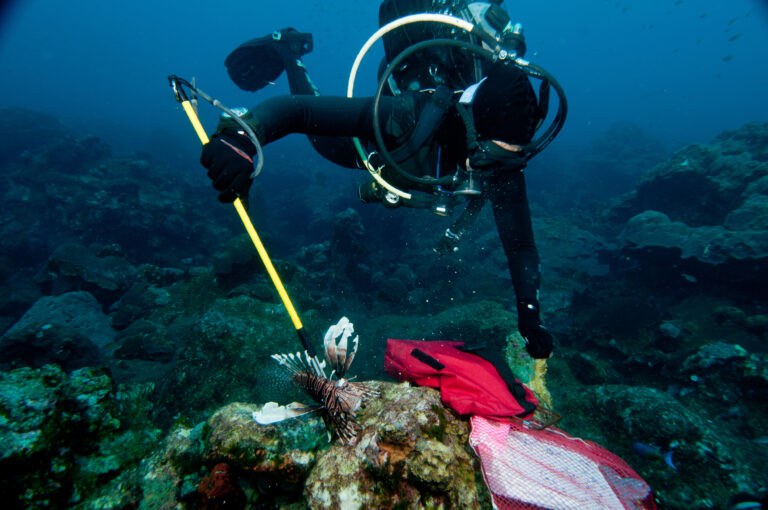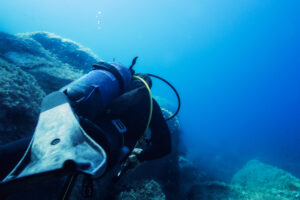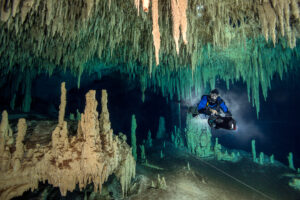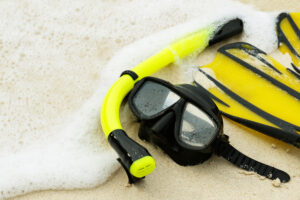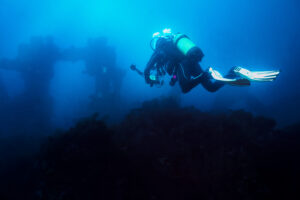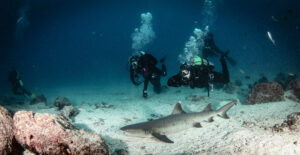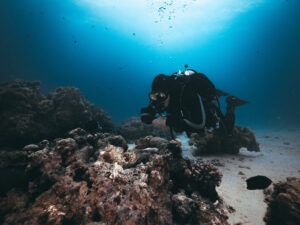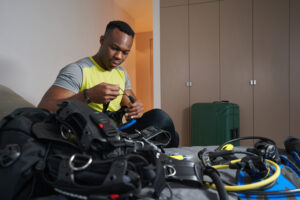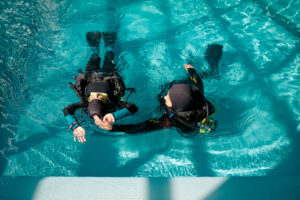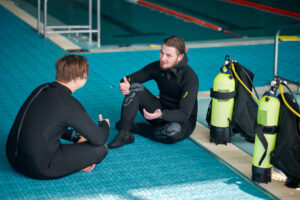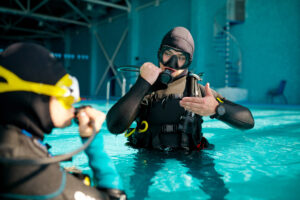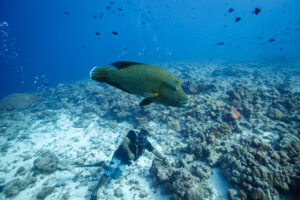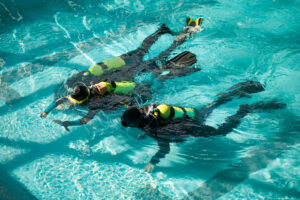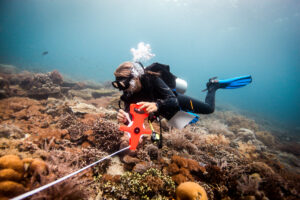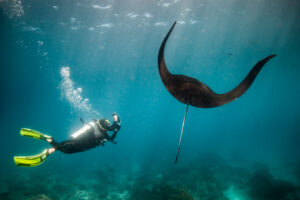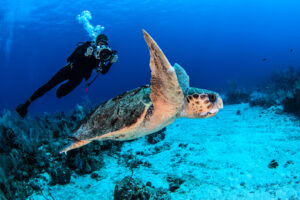What is Octopus Breathing?
Octopus breathing is a critical concept in scuba diving that refers to the use of a secondary breathing apparatus, known as an “octopus,” which allows divers to share air in emergency situations. This technique is an integral part of dive safety protocols, providing a reliable method for a diver to offer their breathing gas to a buddy who may have run out of air or encountered a malfunction with their primary regulator. The octopus system is designed to be easily accessible, typically color-coded, and positioned within reach to ensure quick deployment when needed.
Historical Development
The development of octopus breathing systems has a rich history that reflects the broader evolution of scuba diving technology. In the early days of diving, air-sharing methods were rudimentary, often involving the passing of a single mouthpiece back and forth between divers. This method was not only cumbersome but also posed significant risks due to the potential for miscommunication and delay.
The introduction of the octopus rig marked a significant advancement in diving safety. In the mid-20th century, as scuba diving gained popularity, the need for a more reliable and efficient emergency air-sharing solution became apparent. Early innovators began experimenting with secondary regulators, leading to the development of the octopus system. This system provided a dedicated secondary regulator, allowing for continuous and immediate air sharing without the need for complex hand signals or equipment exchange.
As the sport of scuba diving grew, so did the refinement of the octopus breathing apparatus. Manufacturers introduced more robust and user-friendly designs, incorporating features such as brightly colored hoses and purge buttons to facilitate easier use. The adoption of these systems by diving organizations and certification bodies helped standardize their use, making octopus breathing an essential component of modern scuba diving training and practice.
Technical Description of Octopus Breathing
The octopus breathing system consists of several key components, each playing a vital role in ensuring the diver’s safety. Central to the system is the primary regulator, which connects to the diver’s air tank and supplies breathing gas. Attached to the primary regulator is a secondary regulator, commonly referred to as the “octopus.” This secondary regulator is connected via a hose and is designed to provide an alternate source of air for a diving buddy in need.
The octopus regulator is typically distinguishable by its bright color, often yellow, to ensure it can be easily located in an emergency. The hose connecting the octopus to the primary regulator is usually longer than the primary regulator’s hose, allowing for comfortable air sharing between two divers swimming side by side or slightly apart. The configuration ensures that the octopus is always within reach and can be quickly deployed when necessary.
In addition to the regulators and hoses, the octopus system includes features such as purge buttons and adjustable airflow controls. The purge button allows the diver to clear any water from the regulator, ensuring a steady flow of air when it is first used. Adjustable airflow controls enable divers to fine-tune the air delivery to match their breathing needs, providing a comfortable and efficient breathing experience.
The integration of the octopus system into the diver’s gear is crucial for its effectiveness. The secondary regulator is typically mounted on the diver’s buoyancy control device (BCD) or secured with a clip, making it easily accessible. This strategic placement ensures that in an emergency, the octopus can be swiftly located and used, minimizing the time a diver is without air.
Safety Protocols
Safety protocols for octopus breathing are designed to maximize the effectiveness of the system and ensure the safety of all divers involved. One of the primary aspects of these protocols is the proper training and familiarization with the use of the octopus system. Divers are taught how to locate, deploy, and use the octopus regulator during their certification courses, ensuring they are prepared to handle air-sharing situations confidently.
During an emergency air-sharing scenario, the diver in need approaches their buddy and signals the need for air. The buddy then retrieves the octopus regulator and hands it to the distressed diver. It’s crucial for the buddy to maintain physical contact and eye contact to ensure effective communication and coordination. The distressed diver then begins breathing from the octopus while both divers work together to ascend to the surface or reach a safe location.
Regular practice and drills are essential for maintaining proficiency in using the octopus system. Divers are encouraged to participate in refresher courses and emergency drills to keep their skills sharp and ensure they can respond swiftly in real-life situations. Dive instructors often incorporate these drills into training sessions, simulating various emergency scenarios to build diver confidence and competence.
Proper maintenance of the octopus system is another critical aspect of safety protocols. Divers must regularly inspect and service their equipment to ensure it remains in optimal working condition. This includes checking for leaks, ensuring the hoses are free from damage, and verifying that the regulators are functioning correctly. By adhering to a strict maintenance schedule, divers can trust that their octopus system will perform reliably when needed.
Advantages of Octopus Breathing
Octopus breathing offers numerous advantages over traditional air-sharing methods, enhancing safety and convenience for divers. One of the most significant benefits is the immediate availability of a dedicated secondary regulator. Unlike older methods where divers had to share a single mouthpiece, the octopus system allows for continuous, uninterrupted breathing for both divers. This eliminates the need for complicated hand signals and reduces the risk of confusion or delay during an emergency.
For recreational divers, the octopus system provides an added layer of security, allowing them to enjoy their underwater experiences with greater peace of mind. Knowing that they have a reliable and easily accessible source of emergency air can reduce anxiety and increase confidence. This is particularly important for novice divers who may be more prone to panic in stressful situations.
Professional divers, such as those involved in commercial or scientific diving, also benefit from the octopus system. These divers often operate in challenging environments where the risk of equipment failure or air depletion is higher. The octopus breathing apparatus ensures they have a backup plan, allowing them to focus on their tasks without compromising safety. Additionally, the ability to quickly share air can be crucial during complex underwater operations, where communication and coordination are vital.
The octopus system is also advantageous in situations where divers may be exploring wrecks, caves, or other confined spaces. In these environments, the ability to share air without the need to swap mouthpieces or make significant adjustments to equipment can be lifesaving. The longer hose on the octopus regulator provides flexibility, allowing divers to maneuver through tight spaces while still maintaining a reliable air supply.
Common Challenges and Solutions
Despite its many advantages, the octopus breathing system is not without its challenges. One common issue divers face is the potential for entanglement or snagging of the octopus hose. This can occur when the hose gets caught on underwater obstacles or becomes entangled with other equipment. To mitigate this risk, divers should ensure the hose is properly secured and streamlined, using clips or bungee cords to keep it close to the body and reduce the likelihood of entanglement.
Another challenge is the potential for the octopus regulator to free-flow, a situation where the regulator continuously delivers air even when not in use. This can occur due to improper adjustment, damage, or debris entering the regulator. Divers can address this issue by regularly servicing their equipment and ensuring the regulators are properly tuned. In the event of a free-flowing octopus, divers are trained to use techniques such as covering the mouthpiece or adjusting the airflow control to stop the flow and conserve air.
Ensuring that the octopus regulator is always accessible can also be a challenge. In some cases, the regulator may become dislodged from its mounting point or be difficult to locate in an emergency. To prevent this, divers should routinely check that the octopus is securely fastened and practice retrieving it during training sessions. Using brightly colored hoses and mouthpieces can also help increase visibility and ease of access.
Proper maintenance and care of the octopus system are crucial to addressing these challenges. Divers should follow manufacturer guidelines for regular inspection and servicing, replacing any worn or damaged components as needed. Keeping the equipment clean and free from debris will help ensure reliable performance. By staying vigilant and proactive, divers can minimize the risk of equipment issues and maximize the effectiveness of their octopus breathing system.
Regulations and Standards
The use of octopus breathing systems is governed by various regulations and standards set forth by diving organizations and regulatory bodies. These guidelines ensure that equipment meets safety requirements and that divers are adequately trained to use the systems effectively. Adherence to these standards is crucial for maintaining safety and reducing the risk of accidents.
Globally, organizations such as the Professional Association of Diving Instructors (PADI), Scuba Schools International (SSI), and the International Association of Nitrox and Technical Divers (IANTD) provide guidelines on the use of octopus systems. These guidelines cover aspects such as the proper configuration of the octopus, training requirements, and emergency procedures. Divers seeking certification through these organizations must demonstrate proficiency in using the octopus system as part of their training.
In addition to training requirements, equipment standards play a vital role in ensuring the reliability and safety of octopus systems. Regulatory bodies such as the International Organization for Standardization (ISO) and the European Committee for Standardization (CEN) establish specifications for the design, manufacturing, and testing of scuba diving equipment. These standards ensure that octopus regulators and other components meet rigorous safety criteria, providing divers with confidence in their gear.
Regional regulations may also apply, depending on the diving location. For example, certain countries or regions may have specific requirements for the use of octopus systems in commercial or professional diving operations. These regulations may mandate additional training, certification, or equipment inspections to ensure compliance with local safety standards. Divers should familiarize themselves with the regulations applicable to their diving activities and ensure they meet all necessary requirements.
Key Takeaways
Octopus breathing is a crucial aspect of scuba diving that enhances safety and enables effective emergency air sharing. Understanding the historical development, technical components, safety protocols, advantages, and common challenges associated with octopus breathing is essential for divers. Adherence to regulations and standards ensures the reliability and effectiveness of the octopus system, ultimately contributing to safer and more enjoyable diving experiences.

